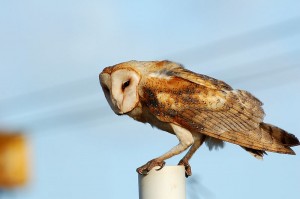LETTER: Hawaii’s ‘Final Solution’ for Egrets and Owls
A few years prior to Hawaii gaining statehood, the government released cattle egrets and barn owls as biocontrol agents to manage agricultural pests, such as rodents and flies. Now, over 50 years later, the unintended consequences of these introductions have come back to roost, with the growing populations of barn owls and cattle egrets allegedly becoming a threat to endangered native birds.
Trying to turn back the clock, the federal government is proposing rule changes to make it permanent open season on cattle egrets and barn owls in Hawaii. While the birds were brought here on work visas, they are now being “terminated.”
You may rarely see barn owls since they are nocturnal, but the sight of flocks of snow white egrets, some sitting on the backs of cattle as they pick off the flies, is now part of the wildlife experience here in Hawaii. For those who love seeing animals and nature, they are beautiful to behold.
Unfortunately, birds, like people, fight and compete over resources. Usually, the fittest survive, and these are often the hardier introduced species. However, when the loser is an endangered native species, the government cries foul.
To their credit, the agencies responsible for wildlife control have tried non-lethal methods to chase away the egrets and owls, but the birds returned. Apparently out of non-cruel options, the government is mandating “the final solution.” State and federal agencies will be ordered to eradicate these birds from Hawaii.
Hawaiian native birds are already struggling with lost habitat, climate change, pollution, disease, and predation by rats, mongooses, cats, and dogs. Killing owls and egrets will probably be too little, too late. But that won’t stop the mass killings.
If you love animals, as I do, you can’t help but feel pity for the egrets and owls. These beneficial, intelligent creatures are now part of Hawaii’s new environment. They are the winners in the struggle for life on these islands. Our environmental policy, however, kills the strong to save the weak. However, since the weak are that way for a variety of reasons, their survival is still questionable, even after the stronger species are eradicated.
On the other hand, you have to feel for the endangered animals, too. Unprepared for modern life and all its challenges, these species are on the brink and need help.
Perhaps we can find our way out of this dilemma with a human analogy. After all, the spread of invasive species has been made possible by the spread of invasive cultures. The immigration dilemma is the same regardless of species.
What are we doing with immigrant cultures that have come to Hawaii, redefining the cultural and physical environments, and threatening the very survival of native Hawaiian culture?
If we used our environmental policy, we would kill the immigrants. That would be the equivalent of non-native species eradication. And this is done in many places in the world in the form of ethnic cleansing. Immigrants are accepted by one generation, proliferate over the next generation, and are denounced in the next. Is violence the only answer?
Since we care about human life here in the Aloha State, we have come up with ways of supporting Hawaiian culture without attacking non-Hawaiians. We can level the playing field by giving strength to those in need, instead of by harming those who are not in need.
Applying that policy to the environment would mean we would help endangered species without harming non-native wildlife. Rather than spending money trying to “cleanse” the entire state of introduced species, we should accept that maintaining critical habitat required by endangered species is a labor intensive, constant effort. There is no final solution.
We would let nature reach a balance with the new and old, while trying to guarantee endangered species the special conditions they need to survive.
The alternative, which is being pursued today by our government, is environmental war. There is also the risk of our violent environmental policy influencing our human policy. If we can’t show compassion, concern, and empathy for helpless birds whose sole crime is that their introduction was successful, then it won’t be long until we lose those same feelings for helpless people whose sole crime is that they are strangers in a strange land.
You may submit comments by one of the following methods only:
• Federal eRulemaking portal: Follow the instructions for submitting comments on Docket FWS–HQ–MB–2013–0070.
• U.S. mail or hand delivery: Public Comments Processing, Attention: FWS–HQ–MB–2013–0070; Division of Policy and Directives Management; U.S. Fish and Wildlife Service; 4401 North Fairfax Drive, MS 2042–PDM; Arlington, VA 22203–1610.
Electronic comments on this proposal must be submitted by 11:59 p.m. Eastern time on Feb. 3, 2014. Comments submitted by mail must be postmarked no later than Feb. 3, 2014.
—
Send letters to editor@bigislandnow.com to bring an issue to the public. If you have a short response to the article above, please leave a comment below.







